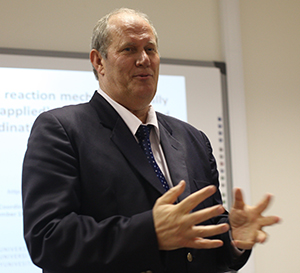
Prof André Roodt |
Prof André Roodt from the Department of Chemistry at the University of the Free State has returned from a research visit at the St Petersburg State University in Russia. The research he conducted at the St Petersburg State University is part of a bilateral collaboration agreement between the University of the Free State and St Petersburg State University.
As part of his visit to Russia (from 17 to 28 September 2015), Prof Roodt presented a seminar at St Petersburg State University, and a lecture at the conference titled: International conference on Organometallic and Coordination Chemistry: Achievements and Challenges.
One of the local Russian newspapers quoted Prof Roodt as “world-renowned expert in the study of chemical kinetics and mechanisms of chemical reactions”. His presentation: Are detailed reaction mechanisms really necessary in (applied) organometallic and coordination chemistry' attracted great interest from the St Petersburg chemists.
The bilateral agreement came to life a year ago when the St Petersburg State University chemists won a grant in a competition to create an international research group, the International Laboratory of Organometallic Chemistry. The Laboratory is headed by Prof Vadim Kukushkin of the St Petersburg State University.
In addition to the employees of St Petersburg University, the research group consists of researchers from Portugal, Finland, South Africa, and Azerbaijan. Together, these groups of scientists are working on the problem of non-reactive metal activation molecules. The main theme of the research laboratory is in the catalysis and activation of metal inert molecules which then undergo significant change, and become meaningful to people chemicals, such as drugs.
As part of this initiative, a bilateral collaboration agreement exists between the St Petersburg State University and the UFS (Russian Science Foundation grant 14-43-00017). Students from our university have visited and conducted research at the St Petersburg State University while some of their students visit and research reaction kinetics at the UFS.
Prof Roodt hosted Valeria Burianova, a student from the St Petersburg University. During her visit at the UFS, she learned about response kinetics. A UFS PhD student, Carla Pretorius, joined the group in Russia where she conducted research on the intermetallic rhodium-rhodium interactions for the formation of nano-wires and -plates, with applications in the micro-electronics industry, and a potential for harvesting sun energy.
The UFS Department of Chemistry extended its international footprint further with three of its students, Mampotsu Tsosane, Petrus Mokolokolo, and Tom Kama, returning from Switzerland after a six-week research visit in the group of Prof Roger Alberto from the University of Zürich. In return, Prof Roodt hosted a Swiss PhD student, Angelo Frei from Zürich, and taught him more about reaction mechanisms.